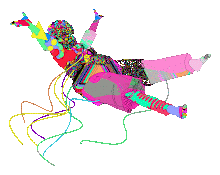




 all photos courtesy by NASA
all photos courtesy by NASA
100th post and no one cares!
20080514
photo session: storms from space
eclipsed to death by
...and you will know us by the trail of dead
@
14.5.08
0
eclipses
![]()
tags: earth, photo session, space
20080513
static world

Saturn's ragged moon Rhea has one of the oldest surfaces known. Estimated as changing little in the past billion years, Rhea shows craters so old they no longer appear round – their edges have become compromised by more recent cratering. Like Earth's Moon, Rhea's rotation is locked on Saturn, and the above image shows part of Rhea's surface that always faces Saturn. Rhea's leading surface is more highly cratered than its trailing surface. Rhea is composed mostly of water-ice but is thought to include about 25 percent rock and metal. The above image was taken by the robot Cassini spacecraft now orbiting Saturn. Cassini swooped past Rhea last month and captured the above image from about 350,000 kilometers away. Rhea spans 1,500 kilometers making it Saturn's second largest moon after Titan. Several surface features on Rhea remain unexplained including large light patches like those seen near the image top.
eclipsed to death by
...and you will know us by the trail of dead
@
13.5.08
0
eclipses
![]()
20080509
the new monster
The Large Hadron Collider (LHC) is a gigantic scientific instrument near Geneva, where it spans the border between Switzerland and France about 100 m underground. It is a particle accelerator used by physicists to study the smallest known particles – the fundamental building blocks of all things. It will revolutionise our understanding, from the miniscule world deep within atoms to the vastness of the Universe.
Two beams of subatomic particles called 'hadrons' – either protons or lead ions – will travel in opposite directions inside the circular accelerator, gaining energy with every lap. Physicists will use the LHC to recreate the conditions just after the Big Bang, by colliding the two beams head-on at very high energy. Teams of physicists from around the world will analyse the particles created in the collisions using special detectors in a number of experiments dedicated to the LHC.
There are many theories as to what will result from these collisions, but what's for sure is that a brave new world of physics will emerge from the new accelerator, as knowledge in particle physics goes on to describe the workings of the Universe. For decades, the Standard Model of particle physics has served physicists well as a means of understanding the fundamental laws of Nature, but it does not tell the whole story. Only experimental data using the higher energies reached by the LHC can push knowledge forward, challenging those who seek confirmation of established knowledge, and those who dare to dream beyond the paradigm.
eclipsed to death by
...and you will know us by the trail of dead
@
9.5.08
0
eclipses
![]()
tags: science
the red friend
Tonight after dark celebrate Astronomy Day by seeing how good your eyes are at telling colors of stars. Look in the west and find the crescent moon.
The first reddish object to the lower right of the moon is the planet Mars. A little further out from Mars towards the horizon is the star Pollux in the constellation Gemini. The moon and Mars however are in the constellation Cancer. The moon is great to look at in this phase with binoculars or telescopes because it has a lot of cool shadows cast by the mountains. You can also see other cool little craters.
In parts of Africa, Europe and Asia, the moon and Mars will appear so close together as seen from Earth that the moon will pass in front of Mars. This is called occultation of Mars by the moon. Some of the mountains and other features were first mapped during an occultation. In 2001, while astronomers were observing a lunar occultation, a meteor struck the moon. For those that are in the viewing area of the occultation find out more here.
In February 2009, you will be able to see two NASA probes crash into Earth’s moon. You will need a telescope to see this, but as the date approaches there will be lots of astronomy clubs/observatories having viewing parties.
If you have those binoculars still handy, you may be noticing a fuzzy patch near the moon. This is the open cluster known as The Beehive. An open cluster is a group of stars that form out of the same stellar cloud. Directly below the moon is a bluish white star that may be catching your eye as well. This is Procyon in the constellation Canis Minor.
photo credit: Doug Zubenel
eclipsed to death by
...and you will know us by the trail of dead
@
9.5.08
0
eclipses
![]()





